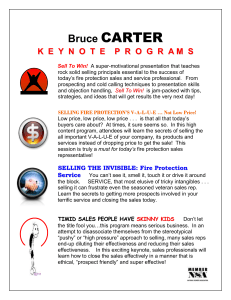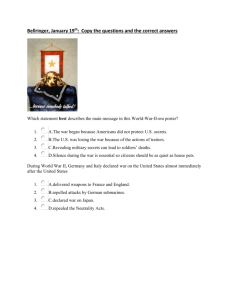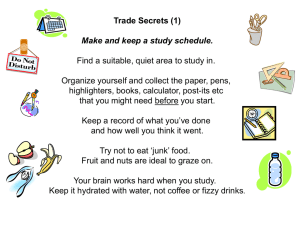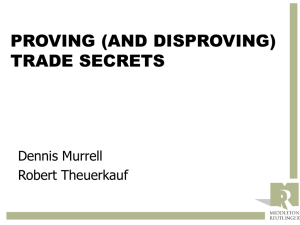I've Got A Trade Secret
advertisement
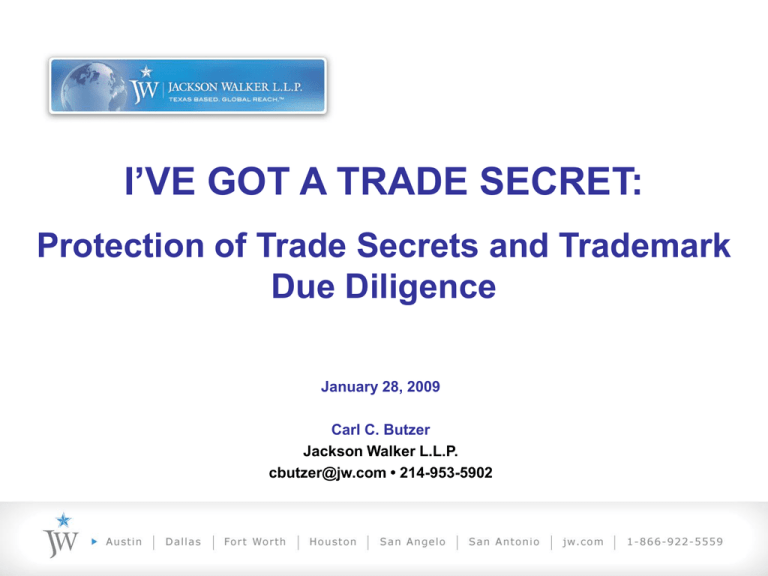
I’VE GOT A TRADE SECRET: Protection of Trade Secrets and Trademark Due Diligence January 28, 2009 Carl C. Butzer Jackson Walker L.L.P. cbutzer@jw.com • 214-953-5902 Trade Secrets • “A trade secret is really just a piece of information (such as a customer list, or a method of production, or a secret formula for a soft drink) that the holder tries to keep secret by executing confidentiality agreements with employees and others and by hiding the information from outsiders by means of fences, safes, encryption, and other means of concealment, so that the only way the secret can be unmasked is by a breach of contract or a tort.” ConFold Pac., Inc. v. Polaris Indus., Inc., 433 F.3d 952, 960 (7th Cir. 2006). Laws Protecting Trade Secrets State-based Uniform Trade Secrets Act (46 states + D.C.) Common Law •Massachusetts •New York •New Jersey •Texas The UTSA & the Restatements Restatement of Torts § 757 (1939) Massachusetts New Jersey New York Texas Uniform Trade Secrets Act (1979, amended 1985) 46 states + D.C. Restatement (Third) of Unfair Competition §§ 39-45 (1995) Liability Under the UTSA 1. the information at issue was a trade secret; and 2. the information was misappropriated. Trade Secret Defined • “A trade secret consists of a formula, process, device, or compilation which one uses in his business and which gives him an opportunity to obtain an advantage over competitors who do not know or use it.” Restatement of Torts, §757 • “. . . information, including a formula, pattern, compilation, program, device, method, technique, or process that: (i) derives independent economic value, actual or potential, from not being generally known to, and not being readily ascertainable by proper means by, other persons who can obtain economic value from a disclosure or use, and (ii) is the subject of efforts that that are reasonable under the circumstances to maintain its secrecy.” Uniform Trade Secrets Act (“UTSA”) “Trade Secret” Information that 1. is not generally known in industry; 2. the owner has made appropriate efforts to keep secret; and 3. confers a competitive advantage by being kept secret. Information Capable of Trade Secret Protection •Formulas •Designs •Devices •Processes •Software •Customer Lists •Know-how •Pricing Information •Compilations •Negative Information Six Factors Used By Courts to Determine Trade Secret Status 1. 2. 3. 4. 5. Extent known outside business; Extent known inside business; Measures taken to guard secrecy; Value of the information; Amount of effort/money expended in developing the information; and 6. Ease or difficulty with which the information could be properly acquired or duplicated by others. Reverse Engineering • “Reverse engineering of chemical . . . articles in the public domain often leads to significant advances in technology.” Bonito Boats, Inc. v. Thunder Craft Boats, Inc., 489 U.S. 141, 160 (1989). Secrecy • “Courts are entitled . . . to economize on their scarce resources of time and effort by refusing to help a secret holder who failed to take minimum steps to protect his secret before running to court.” BondPro Corp. v. Siemens Power Generation, Inc., 463 F.3d 702, 708 (7th Cir. 2006). Protecting Trade Secrets • “[R]easonable efforts to maintain secrecy have been held to include advising employees of the existence of a trade secret, limiting access to a trade secret on ‘need to know basis’, and controlling plant access.” UTSA cmt. §1 How Does the Company Protect its Trade Secrets? • “Based on the lack of repeated losses of confidential information regarding the [process] and [the plaintiff’s] use of physical security, limited access to confidential information, employee training, document control, and oral and written understandings of confidentiality, the Court concludes that [the plaintiff] subjected the [process] to efforts that are reasonable under the circumstances to maintain its secrecy.” Wyeth v. Natural Biologics, Inc., 395 F.3d 897, 900 (8th Cir. 2005) (process for producing bulk natural conjugated estrogens used in the development of Premarin) Protecting Trade Secrets Employees Trade Secrets Protecting Trade Secrets Employees 1. Trade Secrets Need to Know Protecting Trade Secrets Employees Trade Secrets 1. 2. Need to Know Compartmentalize Protecting Trade Secrets Employees Trade Secrets 1. 2. 3. Need to Know Compartmentalize Contracts Protecting Trade Secrets Employees Trade Secrets 1. 2. 3. 4. $ Need to Know Compartmentalize Contracts Transient Protecting Trade Secrets 1. 2. 3. Limited Access Secure Employees Pass Codes / Encryption Trade Secrets Workstation X X Workstation Workstation 1. 2. 3. 4. Need to Know Compartmentalize Contracts Transient? Protection Measures • • • • • • • • • Internal Policies Education & training Monitoring compliance Physical security Isolation of the trade secrets Limit Access (employee mobility/turnover?) Agreements Quality and character of licensees, industry Immediate legal action Resources on Trade Secrets Laws & Opinions • The Trade Secrets Vault http://www.tradesecretsblog.info/ • Jorda On Trade Secrets – The Interface Between Patents & Trade Secrets: http://jordasecrets.com/ • Citizen Media Law Project – Trade Secrets: http://www.citmedialaw.org/legal-guide/trade-secrets • Full-text state statutes and legislation on the Internet: http://www.prairienet.org/~scruffy/f.htm Trademark Due Diligence • Quick self-search: http://www.uspto.gov/main/trademarks.htm • Investigate TTAB proceedings: http://ttabvue.uspto.gov/ttabvue/ • Independent trademark search: e.g., http:// www.compumark.thomson.com/ Trademarks: Identifying potential competitors, infringers, and counterfeiters with similar trademarks • Internet searches • Register appropriate domain names • Register marks with U.S. Customs How has the Target Company Monetized its Trademarks? • Collateralization of Trademarks; • Securitization of trademarks (securitization loans based on licensing revenues)


